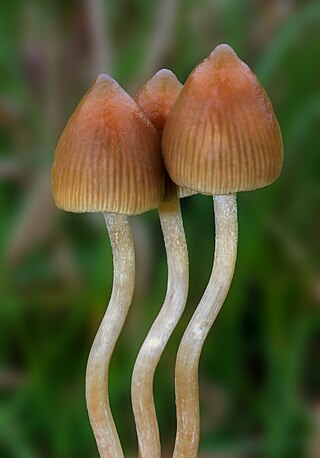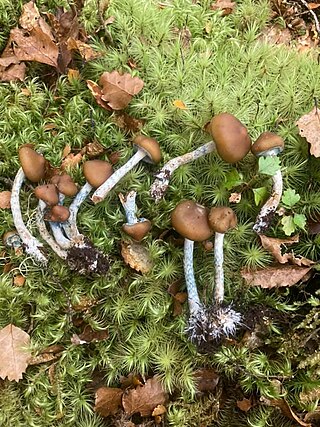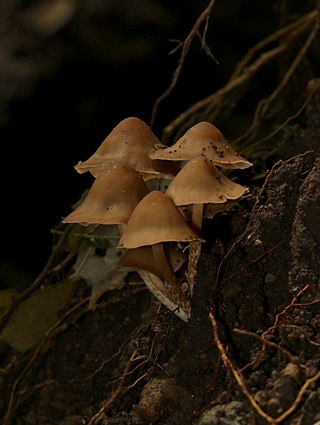
Psilocybe cubensis, commonly known as the magic mushroom, shroom, golden halo, cube, or gold cap, is a species of psilocybin mushroom of moderate potency whose principal active compounds are psilocybin and psilocin. It belongs to the fungus family Hymenogastraceae and was previously known as Stropharia cubensis. It is the best-known psilocybin mushroom due to its wide distribution and ease of cultivation. This mushroom being optimal for home cultivation specifically, as was suggested in the 1970s, is primarily what led to P. cubensis being the psilocybin mushroom species most common on the black market as a street drug.

Psilocybin mushrooms, commonly known as magic mushrooms, are a polyphyletic informal group of fungi that contain psilocybin, which turns into psilocin upon ingestion. Biological genera containing psilocybin mushrooms include Psilocybe, Panaeolus, Inocybe, Pluteus, Gymnopilus, and Pholiotina.

Psilocybe is a genus of gilled mushrooms, growing worldwide, in the family Hymenogastraceae. Most or nearly all species contain the psychedelic compounds psilocybin and psilocin.

Psilocybe semilanceata, commonly known as the liberty cap, is a species of fungus which produces the psychoactive compounds psilocybin, psilocin and baeocystin. It is both one of the most widely distributed psilocybin mushrooms in nature, and one of the most potent. The mushrooms have a distinctive conical to bell-shaped cap, up to 2.5 cm (1 in) in diameter, with a small nipple-like protrusion on the top. They are yellow to brown, covered with radial grooves when moist, and fade to a lighter color as they mature. Their stipes tend to be slender and long, and the same color or slightly lighter than the cap. The gill attachment to the stipe is adnexed, and they are initially cream-colored before tinting purple to black as the spores mature. The spores are dark purplish-brown in mass, ellipsoid in shape, and measure 10.5–15 by 6.5–8.5 micrometres.

Psilocybe cyanescens, commonly known as the wavy cap or potent psilocybe, is a species of potent psychedelic mushroom. The main compounds responsible for its psychedelic effects are psilocybin and psilocin. It belongs to the family Hymenogastraceae. A formal description of the species was published by Elsie Wakefield in 1946 in the Transactions of the British Mycological Society, based on a specimen she had recently collected at Kew Gardens. She had begun collecting the species as early as 1910. The mushroom is not generally regarded as being physically dangerous to adults. Since all the psychoactive compounds in P. cyanescens are water-soluble, the fruiting bodies can be rendered non-psychoactive through parboiling, allowing their culinary use. However, since most people find them overly bitter and they are too small to have great nutritive value, this is not frequently done.

Psilocybe tampanensis is a very rare psychedelic mushroom in the family Hymenogastraceae. Originally collected in the wild in a sandy meadow near Tampa, Florida, in 1977, the fungus would not be found in Florida again until 44 years later. The original Florida specimen was cloned, and descendants remain in wide circulation. The fruit bodies (mushrooms) produced by the fungus are yellowish-brown in color with convex to conic caps up to 2.4 cm (0.9 in) in diameter atop a thin stem up to 6 cm (2.4 in) long. Psilocybe tampanensis forms psychoactive truffle-like sclerotia that are known and sold under the nickname "philosopher's stones". The fruit bodies and sclerotia are consumed by some for recreational or entheogenic purposes. In nature, sclerotia are produced by the fungus as a rare form of protection from wildfires and other natural disasters.

Psilocybe azurescens is a species of psychedelic mushroom whose main active compounds are psilocybin and psilocin. It is among the most potent of the tryptamine-bearing mushrooms, containing up to 1.8% psilocybin, 0.5% psilocin, and 0.4% baeocystin by dry weight, averaging to about 1.1% psilocybin and 0.15% psilocin. It belongs to the family Hymenogastraceae in the order Agaricales.

Psilocybe samuiensis is a psychedelic mushroom, which has psilocybin and psilocin as main active compounds. It was placed in the section Mexicanae of genus Psilocybe by Gastón Guzmán due to its rhomboid-shaped spores. It has been found in Koh Samui, a small tropical island in Thailand, where some psychoactive species are consumed by both natives and tourists. Chao Samui rarely consume psilocybian fungi. Such local use is usually restricted to local females who do so at the request of foreigners.
Psilocybe acutipilea is a species of mushroom-forming fungus in the family Hymenogastraceae. It was discovered in October 1881 in Apiahy, Sao Paulo State, Brazil by Carlos Spegazzini, and described by him as a new species of Deconica in 1889. Gastón Guzmán transferred it to Psilocybe in 1978, but Ramirez-Cruz considered it a possible synonym of Psilocybe mexicana, but the type specimen was too moldy for them to be certain.

Psilocybe banderillensis is a species of psilocybin mushroom in the family Hymenogastraceae known from the states of Veracruz and Oaxaca in Mexico. It is in the Psilocybe fagicola complex with Psilocybe fagicola, Psilocybe oaxacana, Psilocybe columbiana, Psilocybe herrerae, Psilocybe keralensis, Psilocybe neoxalapensis, and Psilocybe teofiloi.

Psilocybe hoogshagenii is a species of psilocybin mushroom in the family Hymenogastraceae. The mushroom has a brownish conical or bell-shaped cap up to 3 cm (1.2 in) wide that has an extended papilla up to 4 mm long. The stem is slender and 5 to 9 cm long. The variety P. hoogshagenii var. convexa lacks the long papilla.

Psilocybe makarorae is a species of psilocybin mushroom in the family Hymenogastraceae. Officially described as new to science in 1995, it is known only from New Zealand, where it grows on rotting wood and twigs of southern beeches. The fruit body (mushroom) has a brownish cap with lighter coloured margins, measuring up to 3.5 cm (1.4 in) wide. The cap shape is either conical, bell-shaped, or flat depending on the age of the mushroom, and it features a prominent umbo. Although the whitish stem does not form a true ring, it retains remnants of the partial veil that covers and protects the gills of young fruit bodies. P. makarorae mushrooms can be distinguished from the similar North American species Psilocybe caerulipes by microscopic characteristics such as the presence of cystidia on the gill faces (pleurocystidia), and cheilocystidia with more elongated necks. Based on the bluing reaction to injury, P. makarorae is presumed to contain the psychedelic compounds psilocybin and psilocin.

Psilocybe moseri is a species of mushroom in the family Hymenogastraceae. The mushroom contains the medicinal compound psilocybin. It is in the section Zapotecorum of the genus Psilocybe, other members of this section include Psilocybe muliercula, Psilocybe angustipleurocystidiata, Psilocybe aucklandii, Psilocybe collybioides, Psilocybe kumaenorum, Psilocybe zapotecorum, Psilocybe kumaenorum, Psilocybe subcaerulipes, Psilocybe pintonii, Psilocybe zapotecoantillarum, Psilocybe zapotecocaribaea, and Psilocybe antioquiensis.
Psilocybe subcaerulipes is a species of fungus in the family Hymenogastraceae. It is in the section Zapotecorum of the genus Psilocybe, other members of this section include Psilocybe muliercula, Psilocybe angustipleurocystidiata, Psilocybe aucklandii, Psilocybe collybioides, Psilocybe kumaenorum, Psilocybe zapotecorum, Psilocybe pintonii, Psilocybe graveolens, Psilocybe moseri, Psilocybe zapotecoantillarum, Psilocybe zapotecocaribaea, and Psilocybe antioquiensis. It is endemic to Japan. Fruit bodies grow on the ground in woody debris, and typically stand 6 to 8 cm tall with caps that are 2.5 to 5 cm in diameter. They are chestnut brown, and stain blue if bruised or handled. The species is a psychoactive mushroom, and contains the hallucinogenic compounds psilocybin and psilocin. There have been reports of poisoning caused by the accidental consumption of this mushroom. It has been used in research, specifically, to test the effects of its consumption of marble-burying in mice, an animal model of obsessive-compulsive disorder.
Psilocybe zapotecoantillarum is a species of mushroom in the family Hymenogastraceae. The mushroom contains the medicinal compound psilocybin. It is in the section Zapotecorum of the genus Psilocybe, other members of this section include Psilocybe muliercula, Psilocybe angustipleurocystidiata, Psilocybe aucklandii, Psilocybe collybioides, Psilocybe kumaenorum, Psilocybe zapotecorum, Psilocybe kumaenorum, Psilocybe subcaerulipes, Psilocybe pintonii, Psilocybe moseri, Psilocybe zapotecocaribaea, and Psilocybe antioquiensis.
Psilocybe zapotecocaribaea is a species of mushroom in the family Hymenogastraceae. The mushroom contains the medicinal compound psilocybin. It is in the section Zapotecorum of the genus Psilocybe, other members of this section include Psilocybe muliercula, Psilocybe angustipleurocystidiata, Psilocybe aucklandii, Psilocybe collybioides, Psilocybe kumaenorum, Psilocybe zapotecorum, Psilocybe kumaenorum, Psilocybe subcaerulipes, Psilocybe pintonii, Psilocybe moseri, Psilocybe zapotecoantillarum, and Psilocybe antioquiensis.
Psilocybe thaicordispora is a species of psilocybin mushroom in the family Hymenogastraceae. Found near Huai Nam Dang National Park, where it grows on the ground in open subtropical forest at an elevation of 1,500 metres (4,900 ft), it was described as new to science in 2012. The specific epithet thaicordispora refers to the section Cordisporae, and to Thailand.
Psilocybe thaiduplicatocystidiata is a species of psilocybin mushroom in the family Hymenogastraceae. Found in Chiang Mai University Park, where it grows on soil with rotting dung, it was described as new to science in 2012. The specific epithet thaiduplicatocystidiata refers to its dimorphic pleurocystidia and cheilocystidia, and to Thailand.

Psilocybe magnispora is a species of psilocybin mushroom in the family Hymenogastraceae. Found in Thailand, where it grows on the rotting dung of Elephas, it was described as new to science in 2009.











